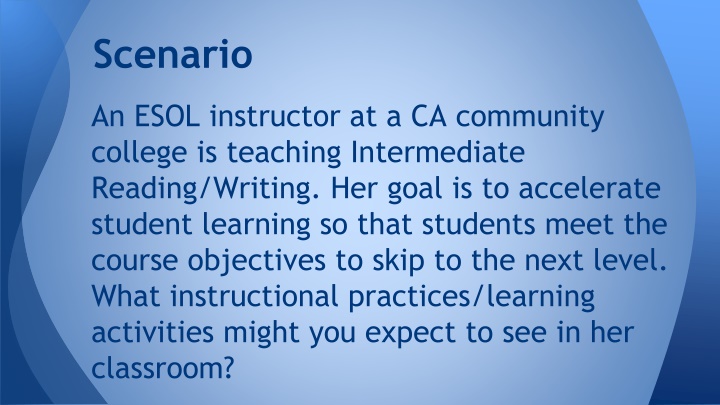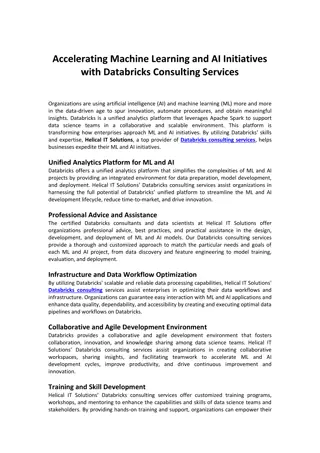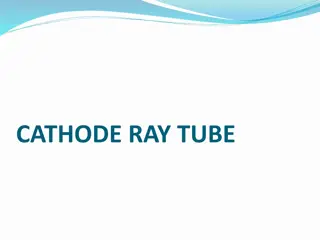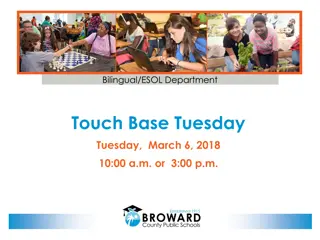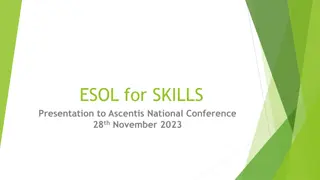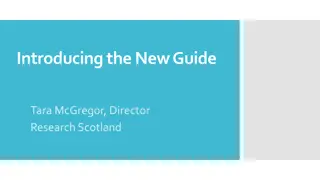Accelerating ESOL Learning Through Innovative Practices
An ESOL instructor at a CA community college aims to accelerate student learning in Intermediate Reading/Writing to progress levels quickly. The instructional practices in her classroom prioritize integration of reading and writing, engaging students in critical thinking tasks, enhancing intercultural communication, and emphasizing sentence-level accuracy. The curriculum redesign focuses on complex tasks earlier, while offering flexible progression through the course sequence. Contextualized learning experiences and interactions with rich texts drive student synthesis, analysis, and criticism skills.
Download Presentation

Please find below an Image/Link to download the presentation.
The content on the website is provided AS IS for your information and personal use only. It may not be sold, licensed, or shared on other websites without obtaining consent from the author.If you encounter any issues during the download, it is possible that the publisher has removed the file from their server.
You are allowed to download the files provided on this website for personal or commercial use, subject to the condition that they are used lawfully. All files are the property of their respective owners.
The content on the website is provided AS IS for your information and personal use only. It may not be sold, licensed, or shared on other websites without obtaining consent from the author.
E N D
Presentation Transcript
Scenario An ESOL instructor at a CA community college is teaching Intermediate Reading/Writing. Her goal is to accelerate student learning so that students meet the course objectives to skip to the next level. What instructional practices/learning activities might you expect to see in her classroom?
Presenters Chelsea Cohen, Lisa Cook, Anna Cortesio, Amy Loewen and Suzan Tiemroth-Zavala ESOL Instructors Laney College (Oakland, CA)
Teach With A Reach: Teaching to Accelerate Students through the ESOL Course Sequence
Our Accelerated Curriculum
Acceleration All students have the opportunity to complete the course sequence from high- beginning to advanced* in 4 semesters *pre-requisite for college English
Peralta ESOL Alternative Structural Model Eliminate levels in course sequence: 6 to 4 Flexible progression through course sequence
Curriculum Redesign Integrate reading and writing Engage students in complex reading, writing and thinking tasks sooner Prioritize at all levels: Critical Thinking Information Literacy: Computer Skills/Research Intercultural Communication/U.S. Culture Comprehension (Reading & Listening) and Production (Writing & Speaking) Sentence-Level Accuracy
Teach with a Reach Design contextualized learning experiences to introduce and build upon meaningful practices... ...rather than teach stacked discrete skills
Teach with a Reach Create compelling contexts in which students and teachers interact with rich texts (rather than textbooks) Engage students in learning practices that require them to synthesize, analyze and criticize
New Model for Professional Learning Support teachers to make that reach. It s a vulnerable place to be.
Laney ESOL Acceleration College (Community of Practice) Instructors engage one another in design and implementation of high-impact teaching and assessment practices aimed at accelerating student learning and progression through the course sequence
Inside the Accelerated Intermediate-level ESOL Classroom When we ask more of ourselves and more of our students at all levels, we surpass our expectations of teacher and student
Exceeding Expectations
good book checklist Newberry Medal the author book reviews
Whats the Reach? Building a context that is compelling and engaging for both students and the teacher Setting students up to be actively involved with the reading Helping students begin to build personal connections to the story
Exceeding Expectations From: Kate Jerome <kate@katejerome.com> Date: February 20, 2015 at 6:10:36 PM PST To: Brenda <godinezbrenda705@gmail.com> Subject: Re: Question about who was Amelia Earhart Dear Brenda, I wrote about Amelia Earhart because she was an interesting woman who was not afraid to take risks. She was also curious ...and had a good sense of humor! Amelia worked hard. I hope you do, too. Good luck on your quiz! Best, Kate Jerome
Exceeding Expectations Student example
Annotation: We Love Messy Books RIGHT MARGIN feelings questions reactions connections LEFT MARGIN facts key events sequence of key events dual story charting
Whats the Reach? Annotation as Building Blocks Reading Group check-in Prepare students for discussion and writing activities Revisit a previous chapter to make connections Look at left side notes for summary creation Look at right side notes for response ideas Trace character and theme development for essay and discussion support
Exceeding Expectations
What are the advantages and disadvantages of owning a pet?
Four Types of Questions These questions will: Direct our discussions from basic comprehension to critical thinking Help us make connections between our own lives and the novel Prepare us for going deeper into a text
1. Right There Questions A right there! question is a question whose answer you can point to in one line of the book.
2. Here and There Questions A here and there question is a question whose answer is formed by assembling information from more than one place in the book.
3. Inside/Outside Questions Only part of the answer to an inside/outside question can be found in the book. The other part of the answer comes from you. What do you infer from what you read?
4. Outside Questions You won t find the answer to an outside question in the book. An outside question is related to an issue in the story, but you ll need to use what you know about the world to answer this question. Join a community of readers and citizens.
Exceeding Expectations: The Socratic Seminar
From Annotation to Summary & Response and Essay
Qualities of a Good Summary Title and author Background information Main idea Important Details Concluding Sentence
Qualities of a Good Response Introduce an idea from the story State your opinion about that idea Give examples to support your opinion Say something meaningful about the reading that the class could discuss
Where does the information we need to write a summary come from? Where does the information we need to write a response come from?
Whats the reach? Demonstrate comprehension Synthesize information Skills with everyday applications Join the conversation Starting point for more complex writing
Exceeding Expectations: A Letter From the Author
Two Prompts Pink: Write a narrative account about a special meal you ve shared with your family. Yellow: In the novel, Sal retells a specific memory about her parents that is triggered by eating blackberry pie. Think of a taste, smell or texture that brings up a significant memory for you. In your narrative, begin by describing the sensory experience and then the significant memory.
Its Your Turn to Join the Conversation Takeaways and Q&A
Course Outline Link to the course outline: http://www.curricunet.com/pccd/reports/course_outline_pdf.cfm?courses_id=10820
ADV B STUDENT ADVANCING FASTER ADV A ADV A HIGH INT B HIGH INT A HIGH INT A INT B INT A HIGH BEG B HIGH BEG A
Visualization #2 of the A/B plan:Stairs ADV B ADV A ADV A STUDENT ADVANCING SLOWER HIGH INT B HIGH INT A HIGH INT A INT B INT A HIGH BEG B HIGH BEG A
Visualization #2 of the A/B plan: Stairs STUDENT ADJUSTING TO PROGRESS ADV B ADV A ADV A HIGH INT B HIGH INT A HIGH INT A INT B INT A HIGH BEG B HIGH BEG A
The next reach... Accuracy!
Example of errors collected from group work with 4 question types: 1. Why did Sal went to the psychiatric ward? ________________________________________________________ 2. Is Ben mom have mental problem? ________________________________________________________ 3. Why Phoebe s mother kissed the lunatic? ________________________________________________________ 4. Did Sal and Ben falling love to each other? ________________________________________________________
Four Types of Questions This idea of the four question types is adapted from a reading apprenticeship technique called QAR (question and answer relationships) by high school teachers Christine Cziko and Lori Hurwitz. http://www.dallastown.net/cms/lib6/PA01000011/Centricity/Domain/204/Microsoft_Word_-_QAR_NOTES_Teacher.pdf http://readingapprenticeship.org/wp-content/uploads/2014/01/RFU-ch-7-QAR-intro.pdf
